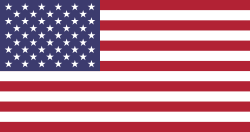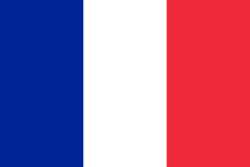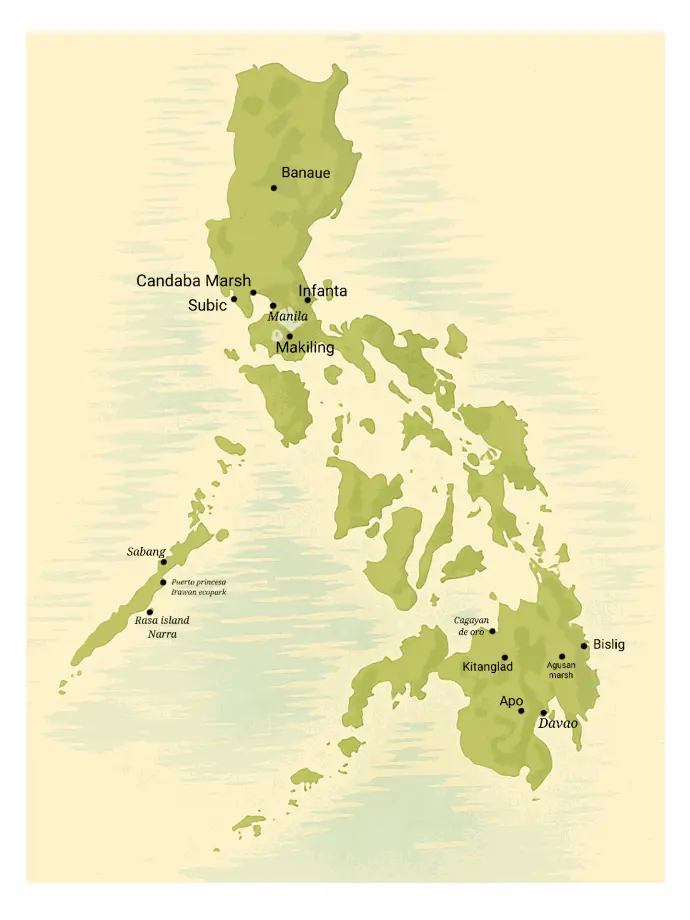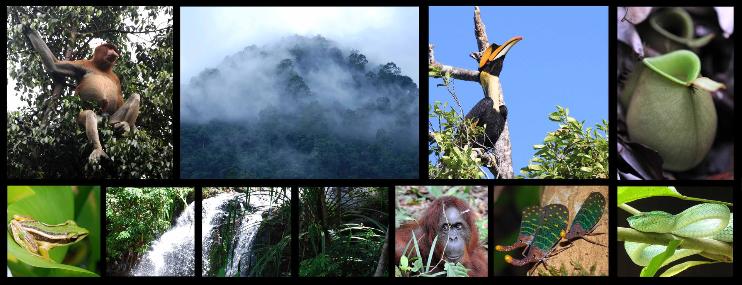Périple insulaire complet, un
voyage ornithologique aux Philippines
À la rencontre d’une avifaune unique au monde
A true paradise for birdwatchers, the Philippines is home to over 700 bird species, including more than 240 found nowhere else on Earth. From the cloud forests of Luzon to the mangroves of Palawan and the wetlands of Mindanao, each island offers its own unique and spectacular birdlife.
This tour is designed for experienced birders looking to encounter some of the archipelago’s rarest and most iconic species — including the legendary Philippine Eagle, the striking Philippine Cockatoo, and the dazzling Celestial Monarch. Guided by expert local ornithologists and staying in comfortable lodges near key birding sites, you'll explore pristine habitats and observe birds in their natural environments, with minimal disturbance.
An unforgettable journey into one of Southeast Asia’s last great strongholds of avian diversity.
Jour 1 – Arrivée à Manille
(dîner)
Accueil à l’aéroport et transfert à votre hôtel. En fin d’après-midi, briefing ornithologique sur le programme, les espèces phares et les zones explorées. Journée libre selon l’horaire d’arrivée.
Jour 2 – Candaba Marsh - Subic Bay
(petit déjeuner, déjeuner, dîner)
Départ avant l’aube pour les marais de Candaba. Observation matinale dans les zones humides, rizières et digues. Route ensuite vers Subic Bay avec un arrêt déjeuner en chemin.
Espèces phares : Canard des Philippines, Héron pourpré, Jacana à longue queue, Rhynchée peinte, rapaces migrateurs.
Jour 3 – Subic Bay
(breakfast, lunch, dinner)
Birding in coastal forest: primary forest, trails and roadside birding.
Key species: Luzon Hornbill, Green Racket-tail, Philippine Falconet, Coleto, Guaiabero
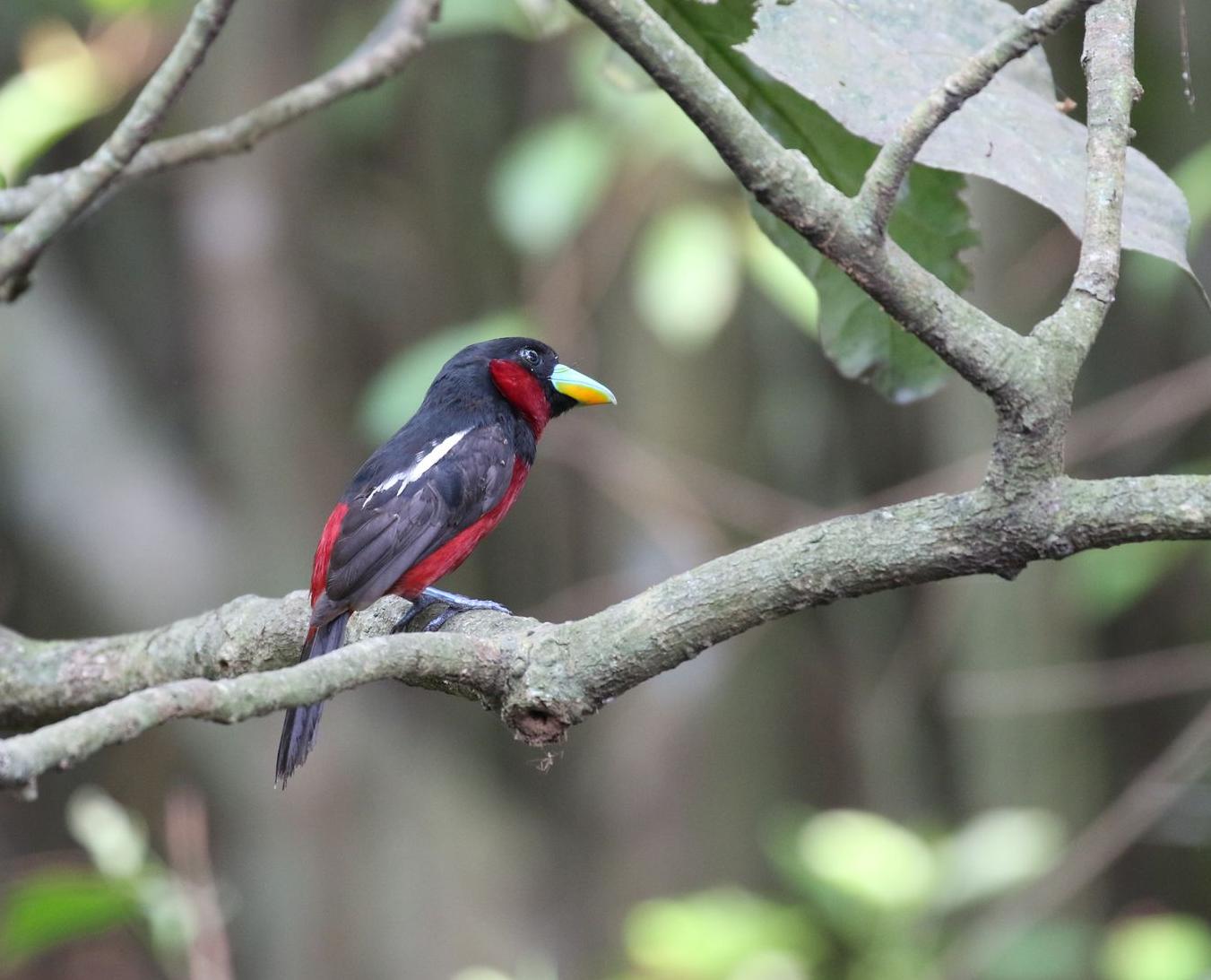
Jour 4 – Mont Makiling
(petit déjeuner, déjeuner, dîner)
Dernière session matinale à Subic pour compléter les observations. Transfert routier vers le mont Makiling, au sud de Manille. Installation et première exploration des abords de la forêt.
Jour 5 – Mont Makiling
(petit déjeuner, déjeuner, dîner)
Exploration des sentiers forestiers de Makiling, riche en espèces de moyenne altitude. Randonnée modérée sous couvert forestier, observation en sous-bois et dans la canopée.
Espèces phares : Malcoha frisé, Souimanga flamboyant, Gallicolombe poignardée, Shama bridé.
Day 6 – Flight to Mindanao
(petit déjeuner, déjeuner, dîner)
Vol intérieur tôt le matin vers Cagayan de Oro, route vers Malaybalay, puis montée facile vers le camp de base. Installation dans la forêt de montagne.
Jours 7–8 – Mont Kitanglad
(petit déjeuner, déjeuner, dîner)
Deux journées complètes d’exploration des forêts d’altitude. Observation à l’aube, en journée et de nuit.
Espèces phares : Aigle des Philippines, Basilorne de Mindanao, Petit-duc de Gurney, Bécasse du Bukidnon, Palette de Mindanao.
Jour 9 – Vol vers Palawan
(petit déjeuner, déjeuner, dîner)
Retour à pied puis en véhicule vers Cagayan de Oro. Vol avec escale vers Puerto Princesa.
Jour 10 – Puerto Princesa → Sabang
(petit déjeuner, déjeuner, dîner)
Route vers Sabang, exploration des premiers habitats forestiers et côtiers.
Espèces phares : Mésange de Palawan, Palette de Palawan
Jours 11–12 – Forêt primaire de Palawan
(petit déjeuner, déjeuner, dîner)
Observation diurne et nocturne en forêt ancienne.
Espèces phares : Éperonnier Napoléon, Calao de Palawan, Podarge de Palawan.
Jour 13 – Sabang
(petit déjeuner, déjeuner, dîner)
Journée plus détendue. Possibilité de faire du snorkeling, une sortie mangrove ou d’approfondir les observations photographiques. Parfait pour cocher les dernières espèces côtières ou forestières.
Jour 14 – Vol retour vers Manille
(petit déjeuner)
Transfert à l’aéroport et vol retour vers Manille. Connexion internationale ou nuit de transit selon les horaires.
Candaba Marsh (Pampanga)
Located north of Manila, along the road to Subic, this seasonal wetland spreads across rice fields and fishponds in the central plain. When flooded, it becomes a lively sanctuary for both migratory and endemic waterbirds.
Target species: Luzon Buttonquail, Chinese Pond Heron, Philippine Duck
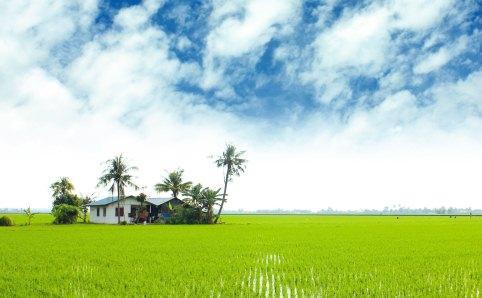
Subic Bay Forest (Zambales)
Just a few hours west of Manila, the forests of Subic Bay roll over low hills covered in tropical trees. Once a military base, this green haven is now a surprisingly well-preserved refuge for many forest species.
Target species: Luzon Hornbill, Philippine Drongo-Cuckoo, Coleto

Mount Makiling (Laguna)
Just two hours south of Manila, this dormant volcano is cloaked in lush forest crisscrossed by research and interpretive trails. It is a key site for discovering Luzon’s avian diversity.
Target species: Green Racket-tail, Long-horned Owl, Luzon Jungle-Flycatcher, Philippine Hanging Parrot

Mont Kitanglad (Bukidnon)
Rising from Bukidnon’s highlands, Mount Kitanglad offers a mosaic of pine stands, grasslands, and montane forest. This is the realm of the national bird, reigning silently over its ancestral domain.
Target species: Philippine Eagle, Mindanao Racket-tail, Apo Myna

Sabang – Parc national de la rivière souterraine
Where the jungle meets the sea, the karst forest clings to limestone cliffs and coastal caves. This majestic landscape shelters a shy and rare fauna.
Target species: Palawan Hornbill, Philippine Drongo-Cuckoo, Palawan Leafbird

Tagabinet / Langogan
North of Puerto Princesa, these quiet villages blend farmland, woodland patches, and mangroves. Forest fragments stretch into nearby hills, and birds are everywhere—along paths and in undergrowth.
Target species: Ashy-headed Babbler, Black Shama, Palawan Leafbird
Dates & prices
Our prices include :
- The services of an English-speaking tour leader,
- Accommodation on the basis of a double or twin room in the hotels mentioned or equivalent,
- Full board meals,
- Transfers and transport on site,
- Les vols intérieurs
- Entrance fees,
- Guide fees.
Our prices do not include :
- International flights,
- The single room option if desired and subject to availability. Price upon request,
- Non-meals drinks,
- Alcoholic drinks,
- Tips and other personal expenses.
- In case of air transport, air surcharges in the event of excess baggage or increased fuel.
- Multi-risk travel insurance (optional)
- Expenses related to force majeure (adverse weather conditions, geopolitical issues, etc.)
La meilleure période pour un séjour ornithologique aux Philippines s’étend de mi-novembre à fin avril, avec un optimum entre janvier et mars. En effet la saison sèche s’étend de novembre à mai, mais de Janvier à mars la météo est plus stable. Le mois de mai est le mois le plus chaud de l’année. Du mois de juin au mois de novembre, c'est la saison des pluies et la période des ouragans.
De plus beaucoup d'espèces endémiques sont plus vocales entre février et avril lors de la période de reproduction, et les espèces migratoires sont visibles de novembre à mars dans les zones humides comme Candaba.
Nous recommandons donc les mois de février et mars.
Easy. The walks carried out throughout the tour do not present any difficulty. It is hot, between 30 and 34°C (86 to 94°F), and the percentage of humidity is high, between 80-95%.
Nous marchons quelques heures par jour au rythme de la marche tranquille avec de nombreuse pause permettant l'observation. Vous êtes en bonne santé et pouvez marcher à un rythme normal, avec un petit sac à dos contenant de quoi vous hydrater.
Accommodation is in 3- and 4-star hotels and rustic campsites in Kitanglad.
Information concerning health and administrative formalities may constantly evolve. It is necessary to check for updates with official bodies.
Visa :
Les ressortissants de la plupart des pays, y compris la France, la Belgique, la Suisse et le Canada, se voient attribuer un visa gratuit pour 30 jours à leur arrivée. Passeport valable au moins 6 mois après la date de retour ; billet de retour ou de continuation; pour un séjour de plus de 30 jours, visa préalable ou extension possible sur place. Une déclaration de voyage est à faire en ligne dans les 72 heures précédent le voyage.
Health
aucune
Feel free to contact us for any clarification or special request.
- Registration: your request is made through the Booking form. We will prepare a quote for you with all the information related to your trip, which you will receive by email within 2 to 5 days of your request.
- Confirmation : Your registration will be final and taken into account by the validation of the quote, our general conditions of sale and the payment of a deposit of 40%. The balance payment must reach us no later than 45 days before the departure date.
